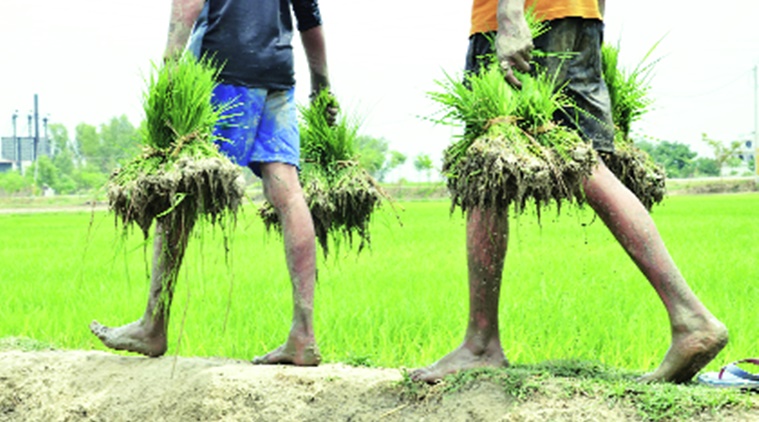 Groundwater has been over-exploited in more than half of Haryana. In as many as 21 blocks, which are known as ‘dark zones’, tubewells are not allowed to be installed.
Groundwater has been over-exploited in more than half of Haryana. In as many as 21 blocks, which are known as ‘dark zones’, tubewells are not allowed to be installed.
The Haryana government hopes to save 12 per cent water this crop season, with farmers applying to shift to alternatives to the water-guzzling paddy, like cotton, bajra and maize in over 2.86 lakh acres under the government scheme ‘mera pani-meri virasat’, this year.
“It is a matter of great satisfaction that farmers have given their consent for growing alternative crops other than paddy in over around one lakh hectare (2.47 lakh acres) of land. Around 12-13 per cent water will be saved this way,” Haryana Chief Minister Manohar Lal Khattar told Union Minister of Jal Shakti Gajendra Singh Shekhawat in a recent video conference. Paddy is cultivated in about 30 lakh acres in the state.
Haryana Additional Chief Secretary Sanjeev Kaushal told The Indian Express Wednesday that their estimate of how much water is expected to be saved is based on calculations of irrigation department officials and agriculture university experts.
This includes water savings from all sources including canal and underground water which is pumped through tubewells for the paddy crop.
However, an official of the agriculture department cautioned to wait till July-end, when the transplantation of basmati variety of paddy will conclude.
“The alternative crops require 80 per cent less water than the needs of paddy cultivation. This way, there will be less consumption of electricity too because of shifting of area to alternative crops from paddy areas. The government will be able to save a subsidy amount which is offered to farmers to supply electricity for tubewells,” said the official. The state has around 8 lakh tubewells.
Groundwater has been over-exploited in more than half of Haryana. In as many as 21 blocks, which are known as ‘dark zones’, tubewells are not allowed to be installed. In total, there are 64 blocks, where groundwater has been over-exploited because of tubewells installed to irrigate paddy and wheat crops.
To produce a kg of rice, according to officials, there is a requirement of 2,000-5,000 litres of water depending upon the soil type and time of paddy sowing. “Maize requires irrigation only 4 times during a crop season, even less if there are sufficient rains, whereas rice requires 40-45 irrigation in general.”
However, the official said that assessing the real picture will take time, because as of now, farmers have only applied to shift to alternative crops from paddy.
“It’s yet to be seen how many farmers actually shift to alternative crops. We will be able to confirm the figures only after completing physical verification of the land of farmers concerned.”
With the available figure, one thing is clear that the farmers returning to cotton and bajra mostly comprise those who had opted for paddy a few years back.
“The farmers of paddy-rich areas will not leave the paddy cultivation too early because they earn considerable savings from this crop because of available water resources including groundwater and canals,” said another official.
Under the ‘mera pani- meri virasat’ scheme, the farmers are offered Rs 7,000 acre as an incentive for opting crop diversification.
‘Farmers face difficulties in selling alternative crops’
However, Bhartiya Kisan Union president Gurnam Singh Chaduni said farmers face difficulties in selling alternative crops.
“Nobody is ready to purchase maize at the rate of government fixed Minimum Support Price (MSP) of Rs 1,760 per quintal. Farmers are forced to sell their produce at the rate of Rs 1,100 per quintal to private players. If there is no smooth procurement of alternative crops, how will the farmers be ready to leave paddy cultivation?” asked Chaduni.
Echoing similar sentiments, Mandeep Nathwan, a farmer leader from Fatehabad district, said, “The cultivators of moong crop are also facing similar problems in selling their produce at the rate of MSP. The farmers want to save water but the government should also understand their problems,” said Mandeep, who had led a tractor march when the government had asked farmers of eight paddy rich blocks to leave paddy cultivation in at least 50 per cent area.
Later, this condition was withdrawn.
Out of 19 blocks where the ground water level is below 40 metres, the government says only eight are paddy rich blocks — Babain, Guhla, Ismailabad, Pipli, Ratia, Shahbad, Sirsa and Siwan.
Despite the government’s focus on these blocks for crop diversification, farmers from these blocks have not shown desired enthusiasm towards the scheme till now.